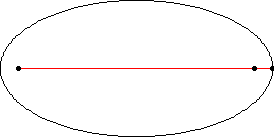Astronomers have identified more than 230,000 asteroids in orbit around the sun, and the number is increasing daily. Some of these objects are on courses that could lead to a collision with Earth. If the asteroid is sufficiently large, the results could be catastrophic.

Two finalists in this year’s Intel Science Talent Search focused on methods for pinpointing the locations of asteroids—predicting where and when collisions could occur and determining the distance from Earth to any nearby object. In both cases, the high school students came up with methods that provide useful answers much more quickly than can other computational techniques now in use.
Andrei Munteanu of Benjamin Banneker Academic High School in Washington, D.C., developed a new method for computing the minimum distance between two bodies following elliptical orbits with a common focus.
Several years ago at an astronomy summer camp, Munteanu learned how to calculate the orbit of an asteroid and became interested in figuring out an asteroid’s mass. He found out that an asteroid’s mass is calculated from its gravitational effect on another asteroid that happens to come sufficiently close to it. Gravity slightly distorts, or perturbs, the two orbits when the bodies are near each other.
The tricky part is identifying two asteroids (out of thousands of possible candidates) that come very close to each other. So, Munteanu had to find a speedy way to calculate the minimum distance between any two asteroid orbits. He soon discovered that this problem was much more interesting than the problem of asteroid mass determination.
Munteanu turned to astronomer Marc A. Murison of the U.S. Naval Observatory for advice and help. As it happened, Murison had been thinking about the same problem but had never had a chance to work on it.
An asteroid follows an elliptical orbit around the sun. The idea is to develop a mathematical equation, or distance function, that expresses the distance between two given orbits in terms of orbit shape and size, as defined by an ellipse’s elongation, or eccentricity, and other parameters.
Munteanu ended up defining a new distance function. For any given pair of orbits, this distance function can be visualized as an undulating surface. Finding the minimum distance means looking for the lowest point on the surface.
To find the minimum and other so-called stationary points of the distance function, Munteanu turned to a numerical technique known as Newton’s method: Make an initial guess, then step-by-step improve on the guess to find the minimum distance to the desired accuracy.
“Our algorithm is orders of magnitude faster than the traditional method of numerically integrating the equations of motion and searching for close approaches,” Munteanu says. He has tested his method by finding the minimum distance between Earth and each of 70,000 asteroid orbits and found it to be surprisingly efficient.
Once the minimum distance is known, it’s possible to calculate the times when two orbiting bodies are closest to each other. So, Munteanu’s algorithm can be used as a “filter” for quickly identifying asteroids that come close to other asteroids or to Earth within a specified time period.
Using conventional numerical methods, astronomers had managed to search for close approaches among only 4,584 asteroids.
“The minimum distance is also an important parameter when it comes to estimating the number of meteors that will be seen during meteor showers or determining whether a long-period comet will come close enough to Earth to be observed,” Munteanu says.
Munteanu and Murison presented their findings last year at a meeting of the American Astronomical Society’s Division on Dynamical Astronomy.
In another step toward identifying asteroids that could pose a threat to Earth, Lisa Glukhovsky of New Milford High School in Connecticut developed a quick and remarkably accurate way to determine the distance from Earth to potentially hazardous asteroids.
With the help of Montgomery Robson, Glukhovsky conducted her research at the John J. McCarthy Observatory in New Milford. Her idea was to determine the distance to a given asteroid by photographing it at the same moment from different places on Earth. Because of parallax, each image would show the nearby asteroid at a slightly different position relative to the background of much more distant stars. This apparent shift in position can be used to calculate the distance to the asteroid.
Glukhovsky arranged to have high school students and amateur astronomers conduct several simultaneous observing sessions at observatories in Europe and the United States. After obtaining the images, she used astrometric software to determine the coordinates of the target asteroid’s apparent position in each image.
These data went into a specially created computer spreadsheet, which encoded the mathematics required to calculate the distance to the target.
“Results for this project far exceeded original expectations,” Glukhovsky says. “Distances to Near-Earth Asteroids were found to a high degree of accuracy using 17 different pairs of simultaneous observations.”
The distances obtained by Glukhovsky differed by less than 1 percent from data provided by the Jet Propulsion Laboratory’s HORIZONS system, which requires powerful computers and takes much longer to determine distances. The biggest error in her calculations appeared to stem from inaccuracies in star catalog positions.
“The results of this project show that by finding the parallax shift of an asteroid with simultaneous imagery, the range to target [asteroids] can to be found to a scientifically useful accuracy,” Glukhovsky concludes.
“Although there were many challenges (such as California forest fires, poor weather at all observatories, and inoperative equipment) throughout the project,” she adds, “with enough participating observatories, this method of ranging asteroids could be used routinely to help refine the orbits of newly discovered Near-Earth Asteroids.”






